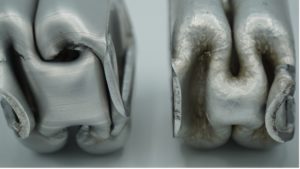High performance & sustainability
How new aluminum alloys for metal additive manufacturin processes will boost additive manufacturing applications.
Author:
Stefan Ritt
VP Market Development at FEHRMANN
Materials, Hamburg, Germany
Since the invention of metal additive manufacturing processes in the mid-1990s, a variety of processes and metal powders have been introduced into the manufacturing market.
Without a doubt laser powder bed fusion (LPBF or SLM) has become the most commonly used process in this field. Various metals and their alloys have become available in powder form to be used for processing with this technology. Stainless steel was one of the first available but soon after that, from approximately 2005 onwards, Aluminium could be processed to satisfy the growing demand from the manufacturing industry.
Although the accuracy and density improved, one basic problem still remained. The choice of Aluminium alloys in powder form stayed very limited. Basically, for most machines, pure Al, AlSi10Mg, AlSi12 and AlSi7Cu as well as very similar alloys were the limited choice compared to several thousand different alloys available for the casting industry.
Additive manufacturing and/or traditional casting
With a rapidly growing demand for Aluminium as a production material not only for the aerospace industry but also for the automotive industry, household appliances, shipbuilding and various other applications, there is a definite need to increase the availability and choice to enable AM-technology to produce parts for industrial applications and at industrial levels.
But how to increase performance of the end use parts compared to traditional casting?
Meanwhile, the LPBF-process for additive manufacturing has reached a technology level to be able to influence the individual voxel of the 3D-CAD dataset which does offer significantly higher influence on the metallurgical structures of parts compared to casting.
If we now make available new high performance aluminium alloys in its powder form, the final part performance is boosted even more. AlMg alloys e.g. can boost the ductility of final use parts by up to 50% which is approximately ten times of the standard values. Please imagine the positive impact this can have on automobile crash tests with the resulting lighter parts design and less use of material which is a secondary but also very important contribution to sustainability.
New alloy designs also do enable higher corrosion resistance, easier coating and electroplating of final production parts. The main advantage is that such new alloys are available not only in powder form but also as ingots to be used in traditional casting shops. Therefore, tests done with prototype parts from AM-processes will also resemble quality attained from series production from casting for higher amounts of parts.
Material recycling made easy
Since the initial production of Aluminium and its alloys, it has become the best recyclable metal of all and millions of tonnes are getting recycled in the industry every year by remelting scrap. Therefore, nearly all material does stay in the circle which is an essential contribution to sustainability of production. It is notable that not more than 5% of the material is usually lost in recycling procedures.
Sustainability starts at the design already!
As often stated in previous publications, when using additive manufacturing, part complexity does come for free when designing the part. If we take this into consideration, the much higher performance values of Al-Mg and Al-Zn alloys will enable the designer to reduce weight and material even further, resulting in a significant material reduction up to approximately 30% of the part.
Design thinking incorporating AMpossibilities
One of the main roadblocks in enabling new parts design which will incorporate all of the above, is the traditional “manufacturing driven design approach” of education, experience and thought process of most industrial designers. Freeform fabrication design requires education and practical work experience of the capabilities that additive manufacturing can offer. Since a few years now, more universities now offer classes on AM-design and use but this is still at its infancy and is not a standard in every engineering faculty globally. This will be a major trigger to bring AM-technology into daily production for the next generation of engineers. Today, only a few percentage of all metal manufacturing is done by additive due to the above reasons. As usual, the aerospace industry is a forerunner here and already actively uses the extraordinary possibilities. Meanwhile, various parts have received flight certification and are used in daily production of aeroplanes as well as in repair. The new trend to boost rocket manufacturing for the micro launcher field for satellites is also using AM heavily as performance, complexity and weight reduction are primary considerations while costs are secondary.
The automotive industry is likely to follow this trend with the increased number of electrical vehicle designs which does shout out for lightweight materials and design due to the actual limited capacity of batteries to achieve the highest possible range of their products.
Summary
The combination of latest AM manufacturing possibilities, new high performance and lightweight alloys and corresponding design will enable not only future product solutions with better technical performance but also a forward-thinking sustainability approach in line with current international political and environmental projects and discussions. The key to success will be the combined use of all disciplines as well as the combination of traditional and future manufacturing methods.
Our future will be what we start today!

Crash deformation simulation of Al-parts, left broken, right only deformed!

Sailing boat front tip cover, printed with SLM-process in AlMg-alloy, courtesy Fehrmann/AMR